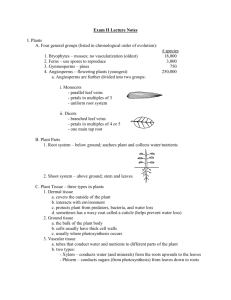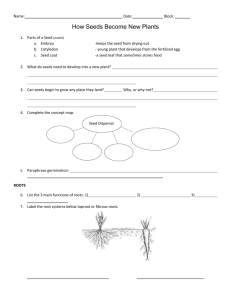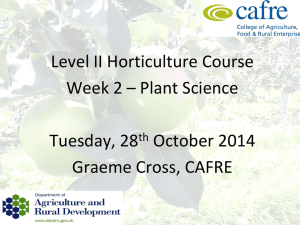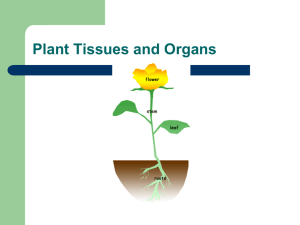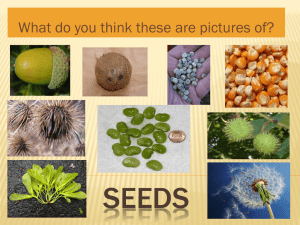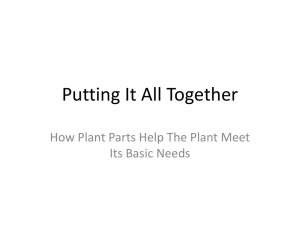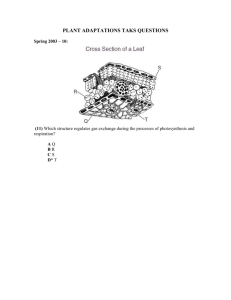plant form and function _1
advertisement
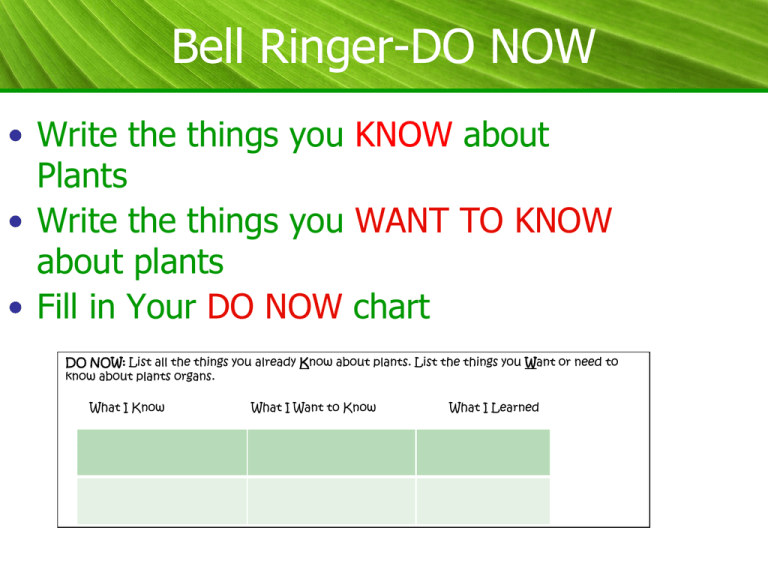
Bell Ringer-DO NOW • Write the things you KNOW about Plants • Write the things you WANT TO KNOW about plants • Fill in Your DO NOW chart DO NOW: List all the things you already Know about plants. List the things you Want or need to know about plants organs. What I Know What I Want to Know What I Learned Plant Biology Form and Function What are we learning today? Benchmark: SC.912.L.14.7 – Relate the structure of each of the major plant organs and tissues to physiological processes. AA Objectives: Identify the major plant organs Discuss the functions of the various plant organs What is the essential question? Plants are complex multicellular organisms with many organs and structures that allow them to carry out all of life’s processes. How do these organs and structures function? Think-Write-Pair-Share How are plant cells different from animal cells? What are the functions of these organelles in plants? What are the types of cells found in plants? Parenchyma Most abundant & least specialized Loosely-packed, cube shaped or elongate Large central vacuole and thin cell walls Functions in storage and photosynthesis Example: fleshy part of an apple or potato Collenchyma Irregular in shape Thicker cell walls but flexible to support new growth regions of the plant Support the growing parts of plant Example: tough strings on a celery stalk Sclerenchyma Thick, rigid, nonstretchable cell walls Often die at maturity leaving empty, box-like structures Support non-growing parts of plants Example: peach pith or nut shell What are the types of tissues found in plants? Plant tissues are organized into three systems: Dermal tissue is like the “skin” of a plant in that it is the outmost layer of cells. Vascular tissue is like the plant’s “veins,” transporting water and nutrients throughout the plant Phloem transports food and xylem transports water Ground tissue is everything else. Ground tissue is made of cells whose cell walls have different thickness. Root Form and Function Two types of roots systems in plants: Taproots Fibrous roots Roots are made up of a Root cap protects the growth zone of the root Root hairs increase water absorption rate Roots have several functions Anchor and support the plant Absorb water and dissolved nutrients from the soil Store food and water. Root Form and Function How is a taproot different from a fibrous root? What are the two main functions of roots? How does a root prevent erosion? How are the roots of most plants adapted to perform the major root functions? How root hairs increases the ability of a plant to absorb water from the soil the plants grows in? Stem Form and Function Stem shape and growth are adaptations to the environment Stems grow in length and thickness Stems have several functions Transport materials between a plant’s roots and its leaves Support leaves and other structures Store food and water Stem Form and Function What are the three main functions of stems? How do the functions of a stem relate to the roots and leaves of a plant? Describe how water is transported through a plant? What is the difference between primary and secondary growth? Leaf Form and Function Main organs that carry out photosynthesis Most leaves are flat to absorb sunlight Leaves have small openings called stomata (stoma) that control gas exchange and water loss. A major limitation of photosynthesis is insufficient water Tiny structures called guard cells control the size of the stomata. Leaf Form and Function What is the function of the stomata? What is the function of guard cells? What is function of leaf veins? Would a 10 foot tree with no leaves but healthy roots be able to move water to its top? Explain your answer. How does the thin, flat structure of leaf helps increase the efficiency of photosynthesis? How does a leaf structure is an adaptation that allows intake of carbon dioxide with minimal water loss? Leaf cross section Vein Mesophyll Stomata CO2 O2 Seed Form and Function Seeds are the reproductive structure that contains a plant embryo Seeds store food that the embryo uses for germination Seeds have a protective coat Seed may contain one (monocot) or two (dicot) seed plants. Flower Form and Function Modified leaves Reproductive structure of angiosperms During pollination, pollen (the male gamete) is transferred from the stamen to the stigma Many attract animals Others are wind pollinated After fertilization it develops into a fruit. Aids in dispersal of seeds Delays germination Protects the seed Cone Form and Function Reproductive organ of gymnosperms (“naked seeds”) Male cones produce sperm Female cones produce eggs. Wind pollinated After fertilization, a seed develops Seeds are not enclosed in protective fruit. Most gymnosperms are hermaphrodites (see picture). Why would it bear male cones on the lower branches, below the female cones? Reproduction Form and Function How are the different part of a flower involved in reproduction? Why is it adaptive for some seeds to remain dormant before they germinate? Why did the development of the seed was a major factor in the success of plants? How do the flowers of wind-pollinated plants differ from the flowers of animal-pollinated plants? How might it be an advantage for a plant to have many flowers together? Why might wind-pollinated plants create more problems for allergy sufferers than animal-pollinated plants? What is the essential question? Plants are complex multicellular organisms with many organs and structures that allow them to carry out all of life’s processes. How do these organs and structures function?
